How to Save the Bald Eagle From Ever Being on Endangered Species List Again
In the United States, at that place may be no greater avian icon — or impressive wild animals improvement story — than the Baldheaded Eagle.
The shaggy, violent-eyed bird has been our national symbol since 1782. It wasn't until the 1960s and 1970s that Bald Eagles became an emblem of the ecology movement as their numbers plummeted from the effects of the pesticide Ddt. One time Ddt was banned and the species was fully protected under the fledgling Endangered Species Act, all the same, eagle numbers began to rebound, gradually at showtime and and so with increasing vigor. In 2007, the U.S. Fish and Wildlife Service removed the Baldheaded Hawkeye from the federal endangered species list.
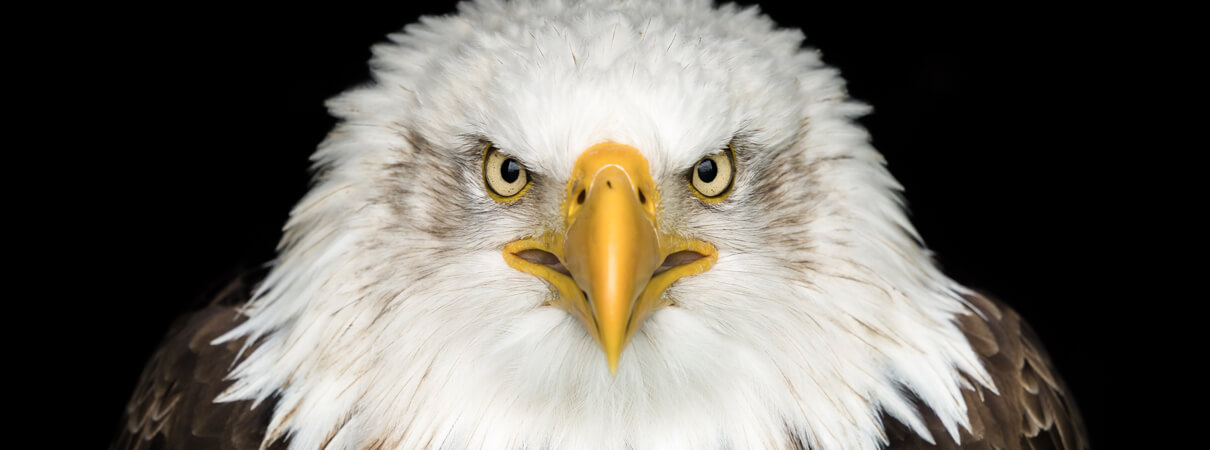
Bald Eagle by Abhijay Wilkinson/Shutterstock
Just what did "delisting" truly mean for Bald Eagles? And a decade later, where does the species stand?
An Icon in Trouble
Adult in the 1940s, Ddt — short for dichloro-diphenyl-trichloroethane — was one of the first synthetic insecticides. Its effectiveness made it popular, but information technology came at a cost: Ddt residuum began to wash off agronomical fields and into aquatic ecosystems, and presently Bald Eagles and other large predatory birds beyond the land were eating contaminated fish. Ingesting the chemicals acquired eagle eggshells to become so thin that large numbers of nests failed.
Rachel Carson's seminal 1962 book Silent Spring helped to spark the environmental movement and exposed the hazards of rampant pesticide use on birds and other wildlife. The Environmental Protection Bureau somewhen banned DDT a decade later, just ii years afterward the agency was established.
Legal protection of Bald Eagles themselves proceeded in a more piecemeal fashion. It began with the passage of the federal Migratory Bird Treaty Act in 1918. Then, in 1940, the Bald Eagle Protection Act (now the Bald and Gold Eagle Protection Human activity) expanded the police's reach, prohibiting the killing or possession of Bald Eagles or their feathers, eggs, or nests. Some eagle populations were listed under the Endangered Species Preservation Act, which became law in 1967; this protection was maintained with the passage of the Endangered Species Human action (ESA) in 1973.
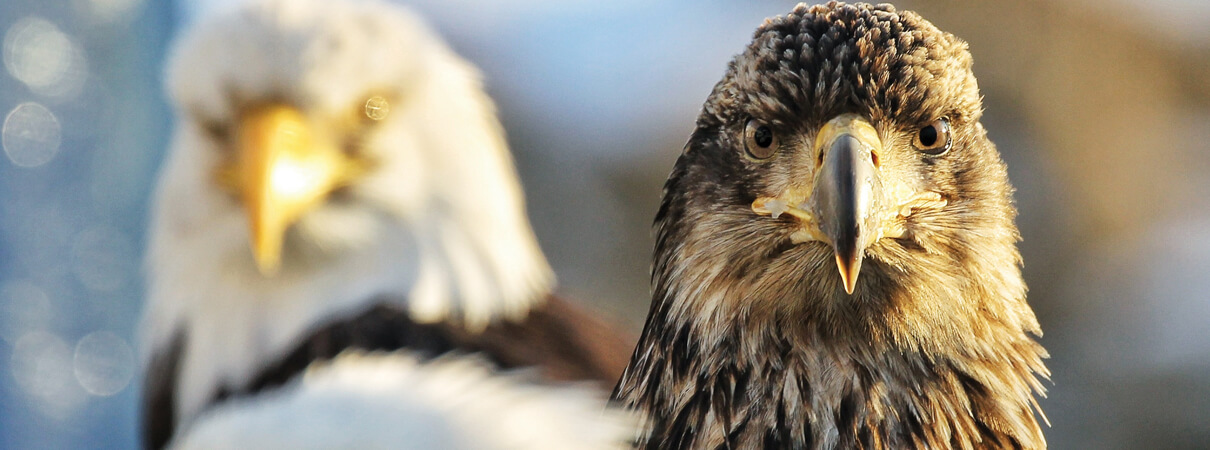
Baldheaded Eagles past Jack Molan/Shutterstock
Finally, in 1978, ESA protection expanded to include Bald Eagles in all 48 face-to-face states. (The eagle population in Alaska had remained healthy, and was never in need of listing.) The resulting efforts to restore the species went beyond the unproblematic elimination of Ddt employ: eagles' nests and habitat were now strictly protected from man disturbance of all sorts.
It worked. In 1963, when the species was at its lowest ebb, there were but an estimated 417 breeding pairs of Baldheaded Eagles in the lower 48 states. By 1997, this number had increased to more than 5,000.
The Fish and Wildlife Service proposed "delisting" the Baldheaded Eagle in 1999, based on the fact that recovery goals for all regions of the country had largely been met a decade earlier — and populations were nevertheless on the ascent. In 2007, information technology became official: the Baldheaded Eagle was no longer endangered, or even threatened. Our national emblem was back.
Eagles on the Rise
Taking the Bald Hawkeye off the endangered species list didn't mean an cease to federal regulations concerning the direction of the species. It just meant their management was once more governed solely by the Bald and Golden Eagle Protection Human action.
The Fish and Wildlife Service at present needed to create a whole new gear up of regulations governing the killing, capturing, or otherwise harming of a protected species. (In regulatory terms, this is known every bit "take" of a species.) No one wants to see an eagle killed by human activity. The question confronting federal officials and conservationists alike was — and remains — how much accept is too much?
The Bald and Golden Eagle Protection Act gives the government the ability to event permits to accept eagles equally long every bit it'due south compatible with the preservation of the species. "But information technology didn't define what that meant," says Brian Millsap, the Fish and Wildlife Service's National Raptor Coordinator. "Then when Bald Eagles were delisted, we divers the preservation of the species as maintaining stable breeding populations. That's a conservative management objective — non only are we non going to let them get extinct, we're going to effort and maintain populations at at least the size they are now."
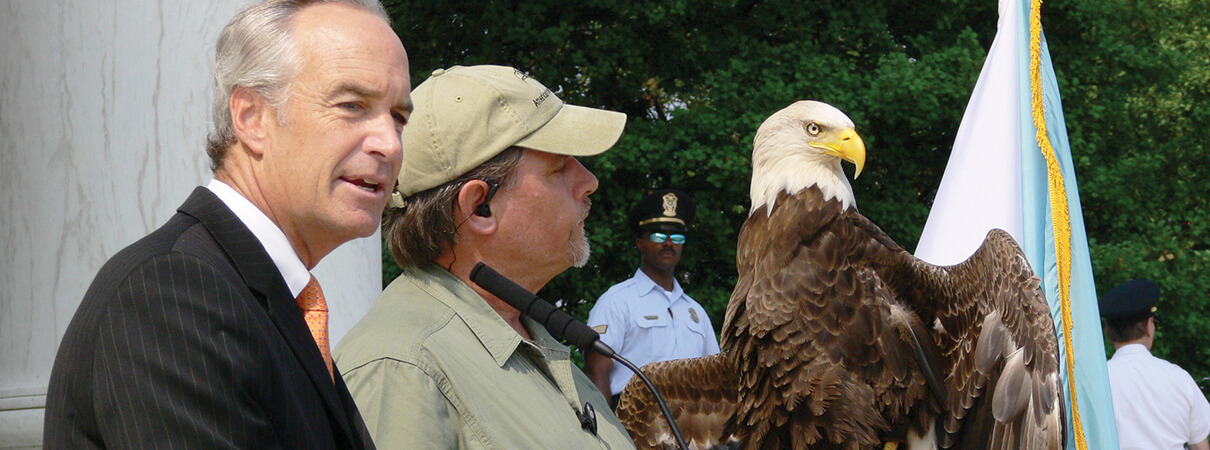
Interior Secretary Dick Kempthorne announces the Bald Eagle's delisting at a ceremony on the steps of the Jefferson Memorial in Washington, D.C., in 2007. Photograph by Mike Parr
In 2016, the Fish and Wildlife Service issued updated regulations governing the take of eagles and eagle nests. ABC, which had sued the Service in 2014 over the previous version of this rule, pushed successfully for the 2016 regulation to crave greater public involvement in the permitting process and that current of air energy companies have independent, third-party monitoring at their facilities, which are frequently deadly to eagles and other birds.
"Bald Eagles are rebounding, but they're even so well beneath their historic numbers," says Steve Holmer, ABC's Vice President of Policy. "Nosotros have to stay vigilant. And now that eagles are off the endangered species list, that ways keeping a shut watch on how they're beingness managed."
Take Action: Help Defend the Endangered Species Act!
Fifty-fifty with new regulations in place, monitoring is crucial to ensuring everything is working equally it should. An ambitious federal plan to survey the entire continent every v years to gauge the number of occupied nests stumbled due to lack of funding afterward its initial implementation in 2009. Simply fifty-fifty that single approximate showed a further substantial increase in the population since delisting ii years earlier: Baldheaded Eagles were estimated to number more 72,000 individuals in the lower 48 states, and virtually 143,000 including Alaska. Millsap says a second round of surveys is occurring correct now. The plan is to accept surveys have place every three years from at present on.
Other sources of information tin hint at what's going on with Bald Eagles, likewise. The North American Breeding Bird Survey, overseen past the U.Due south. Geological Survey and their counterparts in Canada, dispatches skilled volunteers to count birds along set routes across the continent during the breeding season each spring.
The 2016 data showed a v percentage almanac increase in Bald Eagle numbers across the continent. "Nosotros'll see what that translates into in terms of nesting pairs when we complete the survey we're doing right at present," Millsap says. "But the data that we accept suggests that Bald Eagle populations not only increased from delisting until 2009, but that they've continued to increment since so."
On Guard for Threats Old and New
The eagle population nail will almost certainly flatten out eventually. When it does, it may be due to the species naturally hitting its carrying capacity — a term used in ecology to define the maximum population size a region's resources tin sustainably support. But wildlife managers remain on the alarm for new threats. While Dichloro-diphenyl-trichloroethane may be a affair of the by, other toxins both new and one-time proceed to worry those charged with ensuring Bald Eagles' continued success.
Although they hunt fish and other casualty, Baldheaded Eagles are also frequent scavengers, and a gut pile left backside by a game hunter represents a tempting repast. These carcasses oftentimes contain fragments of lead armament, which eagles and other scavengers gulp down along with the meat. Even very small amounts of lead contamination in scavenged meat can be enough to kill an eagle.
The pb problem isn't new. It helped motivate the banning of lead shot for waterfowl hunting in 1991, which reduced Bald Eagles' exposure in the wetlands and lakes that are their preferred habitat. Nevertheless, as populations have grown, more and more individuals have moved into upland areas where the hunting of deer and other large animals is common. Mercury, another heavy metal, is also raising alarms for predator species around the world as it accumulates up food chains.
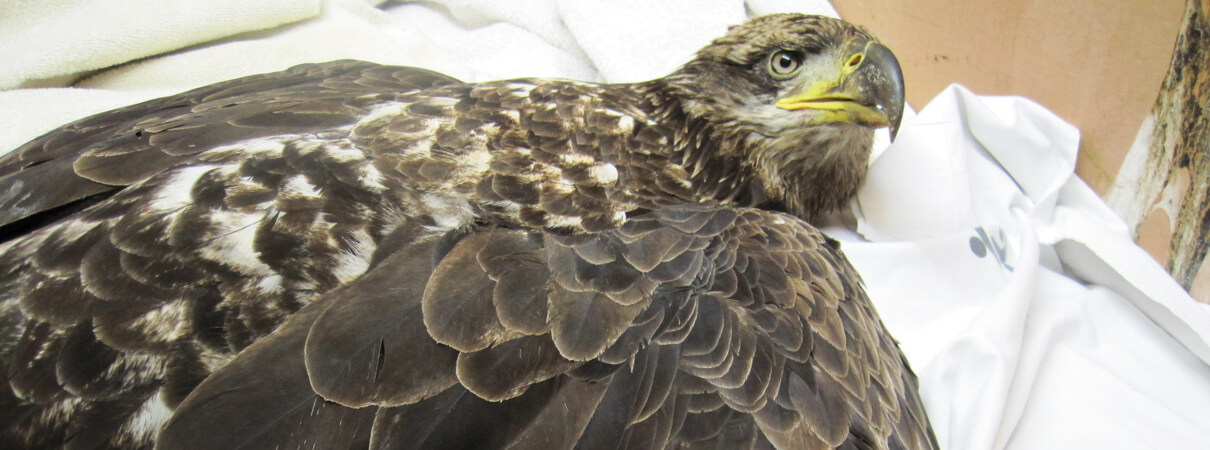
Immature Bald Hawkeye with atomic number 82 poisoning by Marge Gibson
Other pesticides whose effects aren't yet well understood have entered the market, such every bit brodifacoum, one of a broader class of chemicals known as 2nd-generation anticoagulant rodenticides, or SGARs. Although in that location were simply 5 known Bald Eagle deaths from brodifacoum poisoning betwixt 1982 and 2013, compared to 484 from atomic number 82, it's beginning to bear witness up at chronic low levels in even the about isolated Bald Eagle populations, which wildlife managers are at a loss to explicate.
While the future is impossible to foretell, people who know Bald Eagles the all-time are optimistic near what's ahead. And then says Bryan Watts, Director of Virginia's Eye for Conservation Biology and a professor at the College of William and Mary, who studies Bald Eagles of the Chesapeake Bay region. "Eagles aren't going away," Watts says.
A Brighter Future
It's impossible to encounter an developed Baldheaded Eagle soaring overhead without feeling something — a flash of recognition, or peradventure even a surge of promise. Thanks to a patchwork of ecology laws and the efforts of scientists, conservationists, and government agencies, more than of us accept the chance to feel that today than at any time in the past half-century.
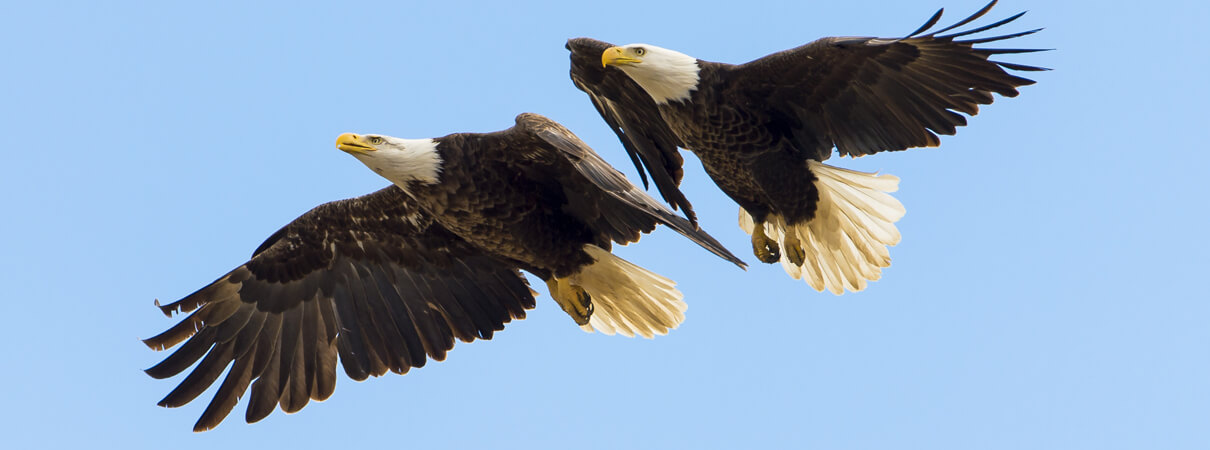
Bald Hawkeye pair in flight by Justin Russ/Shutterstock
ABC's Holmer says the Bald Eagle's rebound doesn't have to exist such a atypical victory. There are many more success stories waiting to happen: 41 U.Southward. bird populations listed under the Endangered Species Act are showing upward trends, he notes, making their recovery a real possibility. For now, though, the Baldheaded Eagle remains a star.
"Bald Eagle recovery is one of the greatest success stories in our nation's history," Watts says. "We should all exist proud that we collectively fabricated a responsible decision about the futurity of this species that Americans care an awful lot virtually."
This article first appeared in the leap 2018 edition of Bird Conservation magazine.
 | Rebecca Heisman is an ecology educator turned-science writer and communicator. |
Source: https://abcbirds.org/bald-eagle-the-ultimate-endangered-species-act-success-story/
0 Response to "How to Save the Bald Eagle From Ever Being on Endangered Species List Again"
Post a Comment